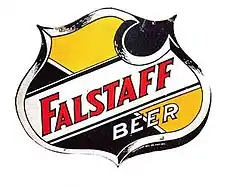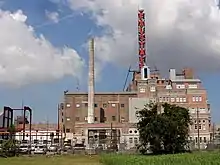Falstaff Brewing Corporation
The Falstaff Brewing Corporation was a major American brewery located in St. Louis, Missouri. With roots in the 1838 Lemp Brewery of St. Louis, the company was renamed after the Shakespearean character Sir John Falstaff in 1903. Production peaked in 1965 with 7,010,218 barrels brewed and then dropped 70% in the next 10 years.[1] While its smaller labels linger on today, its main label Falstaff Beer went out of production in 2005.[2] The rights to the brand are currently owned by Pabst Brewing Company.
 | |
| Industry | Alcoholic beverage |
|---|---|
| Founded | 1903 in St. Louis, MO |
Key people | John Adam Lemp, founder; William J. Lemp, Griesedieck Brothers |
| Products | Beers, lagers, malt beverages |
| Owner | Pabst Brewing Company |
History
.jpg.webp)
Falstaff Brewing's earliest form was as the Lemp Brewery, founded in 1840 in St. Louis by German immigrant Johann Adam Lemp (1798–1862). Over the next 80 years, the Lemp family was devastated by personal tragedies as it built its beer empire over the caves of St. Louis. It adopted its famous "Blue Ribbon" moniker quickly, as an 1898 trial proved when it took the Storz Brewing Company of Omaha to court for tying blue ribbons on its bottles and won.[3] The Lemp Brewery company closed in 1921 and sold its Falstaff brand to the brewery then named Griesedieck Beverage Company. Griesedieck Beverage was renamed the Falstaff Corporation and survived Prohibition by selling near beer, soft drinks, and cured hams under the Falstaff name.[4][5] Falstaff Brewing was a publicly traded company on the New York Stock Exchange, which was rare for a brewing industry in which families closely guarded their ownership.[5]
When Prohibition was repealed in 1933, the first two cases of beer made by the brewery were airlifted from nearby Curtiss Stienberg Airport to the governors of Illinois and Missouri.[6] After Prohibition, the company expanded greatly. Its first acquisition was the 1936 purchase of the Krug Brewery in Omaha, which made Falstaff the first brewery to operate plants in two different states.[2] Other facilities bought in this period included the National Brewing Company of New Orleans in 1937; the Berghoff Brewing Company of Fort Wayne, Indiana, in 1954; the Galveston-Houston Brewing Company of Galveston, Texas, in 1956; San Jose, California in 1952-1973;[7][8] and the Mitchell Brewing Company of El Paso in 1956.[4]
By the 1960s, Falstaff was the third-largest brewer in America, with several plants nationwide. The 1965 acquisition of the Narragansett Brewing Company of Rhode Island proved disastrous, with the state government of Rhode Island pursuing an antitrust case against them. The Supreme Court found in Falstaff's favor in United States v. Falstaff Brewing Corp. (1973),[9] but the company never recovered.
Fortunes declined throughout the 1970s as consolidation swept the beer industry. The company was bought in April 1975 by the S&P Company, owned by Paul Kalmanovitz. In the interim, Chicago White Sox announcer Harry Caray endorsed the brew in live TV commercials, many times with a glass of beer in his hand and sipping it. Kalmanovitz also owned General Brewing, Pabst, Pearl, Olympia, and Stroh's.[4] That year, the company ranked 11th in sales nationally,[5] and the original St. Louis plant was closed. The brewery Falstaff bought in San Francisco in 1971 was closed just a few years later, in 1978.[10][11][12] Subsequent closures included New Orleans in 1979, Cranston and Galveston in 1981, and Omaha in 1983.[13] The Vancouver, Washington, brewery that began producing Falstaff in 1975 closed in 1985, with the entire operation relocated to Zhaoqing, China, and reopened there as a Pabst brewery.[14] After the 1990 closing of the last Falstaff brewery in Fort Wayne, the brand name became a licensed property of Pabst, which continued to produce Falstaff beer through other breweries. Selling only 1,468 barrels of Falstaff in 2004, Pabst discontinued production of Falstaff in May 2005.[15][16]
 Falstaff Brewery building, New Orleans
Falstaff Brewery building, New Orleans.jpg.webp) Vintage Falstaff Beer sign
Vintage Falstaff Beer sign
See also
References
- Yenne, B. (2004) Great American Beers: Twelve Brands That Became Icons. Motorbooks International. p 41.
- "Falstaff Brewing Corporation" Archived 2008-05-03 at the Wayback Machine, Retrieved 4/1/2008.
- Yenne, B. (2004) p 106.
- Tremblay, V.J. (2005). The U.S. Brewing Industry: Data and Economic Analysis. MIT Press. p. 96.
- Mittleman, A. Brewing Battles: History of American Beer. Algora Publishing. p. 110.
- "A New Home for the Museum". Archived from the original on 2012-04-02. Retrieved 2020-11-13.
- "Falstaff Brewery buildings at Cinnabar Street and The Alameda, San Jose, Calif., c. 1955". Calisphere. Retrieved 1 March 2021.
Aerial view of the Falstaff Brewery buildings at Cinnabar Street and The Alameda. The buildings in this photograph were originally built for the Fredericksburg Brewery in 1872. The Pacific Brewing and Malting Company purchased the site in 1936. Falstaff Brewing Corporation bought the Pacific Brewing and Malting Company in 1952. Later operations were consolidated with the San Francisco site. This building was torn down in 1980.
- "Falstaff Plant 6, San Jose, CA 1952 - 1973". a-falstaff-collector.com. Retrieved 1 March 2021.
- United States, Appellant, v. Falstaff Brewing Corporation et al., 410 U.S. 526 93 (S.Ct. 1096, 35 L.Ed.2d 475).
- "Falstaff, San Francisco, CA 1971-1978". a-falstaff-collector.com. Retrieved 1 March 2021.
- Bevk, Alex (13 November 2014). "Shotgunning SoMa's Brewing History with Burgie! Beer". Curbed SF. Retrieved 1 March 2021.
Burgermeister was sold to Schlitz in 1961, and later to Falstaff Brewing in 1971.
- "Falstaff Brewing Corp. – CA 295m". Old Breweries. 20 August 2013. Retrieved 27 November 2021.
- Yenne, B. (2004) p 45.
- "Star Brewery Company of Vancouver, Washington, USA". Tavern Trove. Retrieved 27 November 2021.
- Falstaff Brewing fansite Archived 2013-01-10 at archive.today Retrieved 4/1/2008.
- "History of brewing in St. Louis" Archived 2008-02-28 at the Wayback Machine, Schlafly Beer. Retrieved 4/1/2008.
Further reading
- Baerwald, Craig (2010). "A Past of Brewing and a Future of Urban Development". Urban Action. Department of Urban Studies & Planning, The School of Public Affairs & Civic Engagement, San Francisco State University via:Issuu. Retrieved 1 March 2021.
- "California - Part 15: San Diego...Santa Clara". Old Breweries Information. Breweriana Values. 16 July 2013. Retrieved 1 March 2021.
- Goldthorpe, Jeffrey (1988). Masters' Thesis in Sociology (Thesis). San Francisco: San Francisco State University.
- Naffziger, Chris (25 March 2015). "The History of Falstaff, Part One: Founding a Brewery". www.stlmag.com. Retrieved 1 March 2021.
- Naffziger, Chris (1 April 2015). "The History of Falstaff, Part Two: Prohibition—and The Glory Years that Followed". www.stlmag.com. Retrieved 1 March 2021.
- Naffziger, Chris (8 April 2015). "The History of Falstaff, Part Three: The Beginning of the End". www.stlmag.com. Retrieved 1 March 2021.
- Naffziger, Chris (15 April 2015). "The History of Falstaff, Part Four: The Death of a Great American Brewery". www.stlmag.com. Retrieved 1 March 2021.